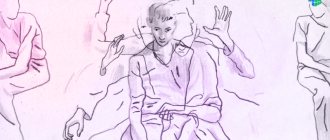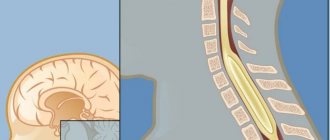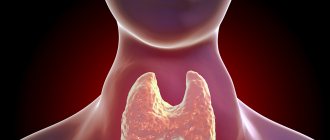Mental and neurological disorders are not uncommon in the modern world. Many of them were identified several centuries ago, but despite this, finding an effective way to treat them was not so easy.
Tourette's syndrome is one of these mysterious and complex disorders. Doctors have still not come to a consensus regarding the causes of its occurrence and methods of prevention. Moreover, according to statistics, 1 in 360 children has symptoms of the disease.
An additional difficulty is the presence of concomitant neurological disorders, which are not always possible to diagnose and treat.
In this article we will try to explain in simple terms what Tourette syndrome is, why it occurs and how you can help people with this disorder. Let's figure it out.
History of the study
Conditions similar to Tourette's syndrome were described in ancient Greece, and in the Middle Ages they were considered manifestations of obsession. In the 1820s, French psychiatrist Jean Itard was the first to describe 10 cases of the disease. His work was later continued by Gilles de la Tourette. He studied and systematized the nervous tics that appear in Tourette's syndrome and determined the nature of the disease. In Russia, Vladimir Bekhterev studied this disease.
For a long time, no one knew about the existence of the syndrome. Photo: freepik.com
Brain plasticity
The human brain has a high degree of what neuroscientists call " plasticity ". This means that the different networks and pathways between brain cells do not stand still, but can change and adapt to new networks and pathways over time.
It is believed that the reason many people grow out of Tourette's syndrome is because their brain effectively "rewires" itself to compensate for the problems they have with the basal ganglia.
Once these changes are complete, symptoms will either improve dramatically or disappear completely.
Reasons for appearance
It is not known exactly why Tourette syndrome occurs. Today it is associated with heredity - the disease often appears in close relatives. However, it has not yet been established which gene is responsible for the appearance of the syndrome. It is believed that external factors may also influence the risk of developing the disease, but the specific causes or conditions for the occurrence of tic disorders have not been identified.
There are a number of factors that influence the severity of symptoms. Among them:
- intoxication;
- increased body temperature;
- past streptococcal infection;
- taking psychostimulants in childhood (with attention deficit disorder, with emotional stress).
Tourette's syndrome is not uncommon. For example, in the United States, every 160 children aged 5 to 17 years suffer from it.
There are several disorders associated with Tourette syndrome (the disease appears against their background or is accompanied by them):
- attention deficit hyperactivity disorder (ADHD);
- obsessive-compulsive disorder (repetitive obsessive behavior or thoughts);
- behavioral problems: anger, aggression, disobedience, socially unacceptable behavior;
- separation anxiety;
- poor learning ability;
- difficulties with social interaction;
- sleep disorders;
- sensory disturbances, such as hypersensitivity.
Symptoms of Tourette's syndrome
The appearance of tics is the main symptom of Tourette's disease. They can be motor or vocal. Motor tics are jerking or involuntary movements. Vocal or vocal sounds - sounds, for example, snorting, screams, words or phrases that a person is forced to repeat (video 1).
Video 1. Symptoms of Tourette's syndrome.
Tics can be simple: a small involuntary movement or utterance of a simple sound, for example, blinking, shrugging, hiccups, smacking, coughing. Complex tics involve several muscle groups at once or are manifested by complex sounds: words, phrases¹. For example, a complex motor tic involves jumping, touching oneself, or copying other people's movements (moving uses multiple muscles). A complex vocal tic is a change in intonation, repeating the same phrase, repeating the words of other people.
When do tics appear, and what to expect next?
Most often, Tourette's syndrome occurs in a mild form and does not require special treatment (only observation by a neurologist or psychiatrist).
Tics are very common. They often appear for the first time in early childhood (from 5 to 7 years), but the disease can also debut in adolescents. Tourette syndrome occurs more often in boys than in girls. Typically, after the first appearance, tics gradually become more frequent and noticeable. In most cases, the disorder peaks between ages 8 and 12, after which symptoms begin to subside. However, for some people they can last a lifetime.
A person with Tourette syndrome has difficulty controlling their own tics. They are preceded by warning sensations (aura), urges that force you to make a movement or utter a sound. This is comparable to the itching or feeling that occurs before sneezing. Unpleasant sensations gradually increase, and relief occurs only after the person makes a movement or makes a sound.
When a person is focused and concentrated on something (for example, reading, interesting work, physical activity), the preceding sensations (and the tics that follow them) appear less frequently. This feature is used in the treatment of Tourette's syndrome using cognitive behavioral therapy. The therapist teaches how to manage behavior and concentration so that the urge to tics appears less frequently.
Before the tick the following may appear:
- burning or stinging in the eyes;
- increasing muscle tension;
- dry or sore throat;
- sensation of a foreign body in the throat;
- skin itching.
A person can learn to control tics - for example, during school or at work, when he communicates with other people. However, after long periods of such control, release may occur, in which the tics are repeated many times over a short period. Stress, fatigue, agitation, or feeling unwell can make tics worse.
5 Facts About Tourette's Syndrome
- The syndrome first appears in children and adolescents and often goes away completely upon reaching puberty.
- The child cannot control his tics. It is very important to support him and look for treatment approaches together with his doctor.
- The condition does not affect mental abilities or development, but tics may cause problems with socialization and learning.
- Punishing a child for tics is useless and cruel. It is better to help him, support him and teach him to cope with the disorder.
- Tourette's syndrome is a common condition. Up to 12% of children experience tics, in 3-4% the tic disorder becomes chronic, and in 1% Tourette syndrome develops.
There are four degrees of severity of Tourette's syndrome:
- Mild, in which the person has good control over the symptoms, they are not noticeable to other people, and the patient has short periods when there are no tics at all.
- Moderate, in which the ability to self-control is preserved, but the tics are noticeable to others.
- Severe - it is almost impossible to control the manifestations of the disease.
- Severe - manifests itself mainly in complex motor and vocal tics that a person cannot control (Fig. 1).
Figure 1. Tics of varying complexity.
Source: MedPortal Tourette syndrome in children most often does not affect intellectual development, but associated communication problems, impulsivity, and emotional instability can complicate learning2.
Sometimes the disease is accompanied by other disorders: obsessive-compulsive disorder, aggression, attention deficit hyperactivity disorder, panic attacks.
Classification
Modern classifications of the syndrome are based on the severity of the lesion and the main manifestations of the disease. Pathology is divided into several degrees, among which are:
- Mild degree. The patient is no different in appearance from healthy people. Attacks of tics occur quite rarely. During the course of the disease there are asymptomatic periods.
- Moderate degree. Vocal and motor disturbances become noticeable to strangers and become more and more alarming. Self-control of actions is still possible, but to a lesser extent.
- Pronounced degree. At this stage, the symptoms of the syndrome are practically uncontrollable.
- Severe degree. Patients can no longer regulate their behavior and lose their sense of morality and compassion. They are rude to others, show obscene gestures, and commit rash acts. At the same time, their instinct of self-preservation “turns off.”
Over the years, the signs of the syndrome dull and become less noticeable, or stop bothering them altogether. In rare cases, the disease is chronic and persists throughout life.
Diagnosis of the disease
The appearance of tics does not always mean that a person has Tourette syndrome3. This diagnosis is correct if:
- Symptoms first appear in childhood or adolescence (before 18 years of age).
- Simple or complex motor tics are accompanied by at least one vocal tic.
- Symptoms persist longer than 1 year.
- The disease progresses in waves, its manifestations become more or less pronounced.
- The appearance of symptoms is not associated with the use of psychoactive substances.
With temporary tic disorder, symptoms resolve in less than a year. Chronic (persistent) tic disorder lasts longer than a year, but the tics can only be motor or vocal. Temporary and chronic tic disorder is not Tourette's syndrome.
Diagnosis of the syndrome is performed by a neurologist or psychiatrist. He conducts a survey during which he needs to describe the manifestations of the disease, tell how long they last, how often they appear.
What signs indicate Tourette syndrome in a child?
Usually the disease becomes noticeable at the age of 5-7 years. You should consult a neurologist if you often experience rapid, repetitive, involuntary movements of the face, hands or body. It can be:
- blinking (Fig. 2);
- grimaces;
- nose twitching;
- movements of the neck, arms or legs.
Tics may change, but they persist and gradually intensify.
Vocal tics appear later, but in some children they appear almost simultaneously with motor ones. Figure 2. One of the signs of the syndrome is severe blinking. Source: Tourette's Doesn't Have Me", HBO and the Tourette Syndrome Association / Wikipedia (Creative Commons Attribution-Share Alike 3.0 Unported) When diagnosing Tourette's syndrome, the following methods are used for examination:
- A clinical urinalysis is performed to determine the levels of catecholamines and metabolites in the urine. This allows you to evaluate the excretion of dopamine, norepinephrine, homovanillic acid in order to judge the violation of dopamine secretion.
- Electroencephalography is a study of the electrical activity of the brain, allowing one to evaluate the functions of its structures.
- Electromyography is a recording of myograms of muscles involved in motor involuntary movement.
- Computed tomography or magnetic resonance imaging to visualize the brain.
These methods are used in diagnosis only in cases where, in addition to tics, there are tremors, signs of epilepsy, visual or cognitive impairment. They help distinguish Tourette's syndrome from autism, epilepsy, schizophrenia and a number of other diseases.
Prevention
The risk of genetic and other pathologies, including Tourette's disease in a child, is significantly reduced by the absence of bad habits in parents during the period of planning and conception. As well as a balanced diet, peace and relaxation for the expectant mother. Heredity is difficult to predict here. Even if there are (no) cases of such a disease in your family, this does not mean anything. Parents with this diagnosis have a significant risk of conceiving a potentially sick baby.
How to prevent the progression of Tourette's disease in a child?
If the syndrome has already been identified, adults can create a favorable emotional climate in the family, provide psychotherapy, and rehabilitation. Mothers and fathers, first of all, must support a child who is having a difficult time among his peers, protect and protect him from both physical and mental trauma. Mood and emotions “make” such children, so the course of the disease largely depends on the internal state.
Attention! Psychiatrists advise parents of children with Tourette's pathology not to be shy about displaying them in public places, but to confidently explain the reason for such behavior to others. The mother's shame creates guilt and tension in the child.
Treatment of Tourette's syndrome
Mild cases of the disease may not require treatment, but even then the disease is important to control. If the tics persist, increase, and affect the quality of life, treatment is carried out by a neurologist. The doctor may prescribe psychotherapy and medications.
Psychotherapy
Cognitive behavioral therapy is the mainstay of treatment for Tourette syndrome.
Photo: photographee.eu / Depositphotos Psychotherapy begins with information and training. It is important for the patient to know what is happening to him, how he can control the disease, what affects his condition. This helps to build the right tactics of behavior, to avoid stress, overwork, and the influence of other factors that increase tics.
Important! When a child is diagnosed with Tourette syndrome, parental support is especially important. Tics can affect relationships with peers, self-esteem, and emotional state, but they do not impair mental abilities or slow down development. It is necessary for parents to help the child adapt to this condition and learn to manage it. This will avoid concomitant disorders, ease the course of the disease, and reduce its impact on the child’s life. You can contact not only a neurologist, but also a child psychologist to get additional help.
At the first stage of therapy, an adult is told about the nature of the disease, its possible manifestations, ways to control tics and achieve remission. The patient is taught to recognize an approaching tic and to respond correctly to it.
Cognitive behavioral therapy (CBT) is used for treatment, during which a person learns relaxation techniques, techniques that help control tics, and the correct behavior when urges or “precursors” appear4. Tourette syndrome occurs differently in different people, and therefore each patient will have their own specific set of techniques that will be effective. During behavioral therapy, the therapist helps you identify them and learn how to use them. One such technique is replacing the tic with a less noticeable or prominent action. Meditation, breathing exercises and other methods can also be used.
Psychotherapy can also address related problems associated with Tourette's syndrome:
- depressive disorder;
- anxiety;
- panic attacks;
- ADHD;
- anger, aggression;
- emotional instability;
- low self-esteem;
- social maladjustment and others.
The use of psychotherapy is very important in the treatment of Tourette syndrome. It alleviates the condition, helps cope with tics, and the disease has less impact on the patient’s quality of life. Behavioral therapy can be supplemented with art therapy, music therapy, and animal therapy.
Memo for parents: how to help a child with Tourette syndrome?
- Seek help: together with your child, undergo an examination with a neurologist and psychiatrist and find a psychotherapist who will help you learn to control tics and manage the situations or sensations that provoke them. But: don't rely on medications alone. Cognitive behavioral therapy gives good results, and it is better to start treatment with it. Do not turn to specialists who offer only drug treatment and consider Tourette syndrome to be an incurable disease.
- Support: the child needs the support of his parents.
Help him adapt to society. The calmer the child himself reacts to tics, the less they attract the attention of other people. But: support should be comfortable. Overprotection can make the situation worse. It is better to plan your behavior together with your doctor. Communication with other parents whose children have Tourette syndrome helps. On social networks you can exchange experiences and knowledge, as well as get support for yourself. - Cope together: Ask your child how you can help him or her during tics.
Sometimes the actions of parents can interfere: for example, a mother wants to hug her child at the moment of a tic, but this makes him feel worse. But: do not scold your child, do not try to “forbid” him from tics and do not punish him for them. All this will only worsen the situation. - Observe: Try to identify factors or situations that trigger tics and avoid them or reduce their influence.
It is important to monitor your general health, especially if the psychiatrist prescribes medications: you need to monitor for side effects. But: do not try to interpret symptoms or test results on your own, do not use medications without a doctor's prescription, and do not try to use traditional recipes.
Drug therapy
The following types of drugs can be used in the treatment of Tourette syndrome:
- alpha-2 adrenergic agonists;
- antipsychotics;
- dopamine receptor blockers, drugs that destroy dopamine;
- antiepileptic drugs;
- serotonergic agents5.
These medications can only reduce the symptoms of the disease, but it is impossible to cure Tourette's syndrome with pharmacotherapy. All medications must be selected by the attending physician. First, the lowest possible dosage is always prescribed, at which the symptoms become less pronounced. When the patient's condition improves, the dose of the drug is reduced.
Important! Medicines are prescribed to children only if Tourette syndrome affects the emotional state, reduces self-esteem, and complicates relationships with peers. Prescription of medications can be avoided if psychotherapy is started in time, if the child receives support from parents and is able to adapt to his condition.
If comorbid conditions develop with Tourette syndrome, your doctor may prescribe medications to help manage them, such as low-dose stimulants for ADHD or serotonin reuptake inhibitors for obsessive-compulsive disorder.
New treatments
Deep brain stimulation (DBS) is a method of surgical treatment of certain movement disorders (parkinsonism, various hyperkinesis), the essence of which is the implantation of microelectrodes into certain areas of the brain6.
Another direction is the use of botulinum toxin, which relaxes muscles. Its use reduces the severity and frequency of motor tics, but the effect is temporary; this treatment method is used to correct tics of facial muscles.
Sometimes relief of symptoms occurs unexpectedly when treating conditions other than Tourette's syndrome. For example, in Japan, a connection was found between the severity of tics and the use of aligners (elastic mouthguards that are worn on the teeth to correct malocclusion and treat bruxism). When wearing aligners, tics occurred less frequently and were weaker.
What should you not say to someone with Tourette's syndrome?
If someone around you has Tourette's syndrome, try to treat them with care. An error would be phrases like these:
- You don't have any illness. I've never noticed your tics.
- Why don't you ever swear?
- It's all in your head. Just try to control yourself.
- Don't worry, I also think every now and then that I have Tourette's syndrome.
- If you try, you can easily get rid of tics.
- Can you be quieter!?
Prognosis and course of the disease
Tics occur in many children, but they often go away so quickly that they are not even diagnosed. Only 0.3-0.8% of children are diagnosed with Tourette's syndrome, and 1% of these continue to have it into adulthood6. This disease is not dangerous to health, does not affect development, but can cause behavioral and social problems. It is more severe at high levels of stress, if a person tries to suppress tics, if he does not receive support, if the disease is not treated.
Tourette's syndrome and learning
If a child with Tourette syndrome has multiple motor and vocal tics, he can be homeschooled. To do this, you need to pass a psychological-medical-pedagogical commission (PMPC). This commission will assess the child's health status. She may recommend further schooling, training according to an individual plan or an adapted program, or transfer to home schooling. If the disease persists into adulthood, severe cases may result in disability. This will provide a number of social benefits, including exemption from conscription and the right to receive benefits.
The prognosis will be favorable if:
- contact a neurologist and psychotherapist as soon as possible;
- apply ways to manage stress, emotions, self-esteem;
- use techniques to “replace” or weaken tics;
- treat concomitant diseases or disorders.
Sometimes Tourette's syndrome greatly reduces the quality of life, affects the psychological state, and interferes with social adaptation. It is important to treat this disease and remember that even with it, a person can lead a normal life and achieve success.
Billie Eilish has Tourette's syndrome
The story of the famous American singer Billie Eilish confirms that Tourette syndrome can be controlled and you can lead a full life (video 2).
Video 2. Billie Eilish has Tourette syndrome.
Billie Eilish hid the disease for a long time, but in 2021 she admitted that she has Tourette syndrome. After this, the singer received many messages from fans who also have this disease or simply support her. The singer says that she has lived with the syndrome all her life, has learned to control it well, and her loved ones perceive its manifestations as something normal.
Billie Eilish lives with Tourette syndrome. Photo: benhoudijk/Depositphotos
Forecast
Two thirds of people will experience a noticeable improvement in their symptoms, usually about 10 years after they started. Many of these people no longer need medication or therapy to control their tics.
For some people, Tourette's symptoms become much less bothersome and frequent, while for others they may disappear completely.
The remaining third of people with Tourette syndrome will have symptoms throughout their lives, but symptoms tend to get milder as they get older. This means their need for medications and therapy may subside over time.











